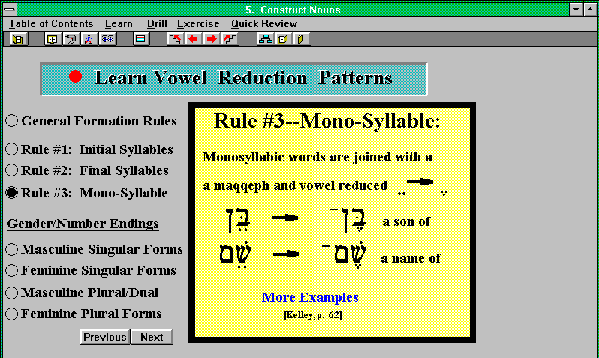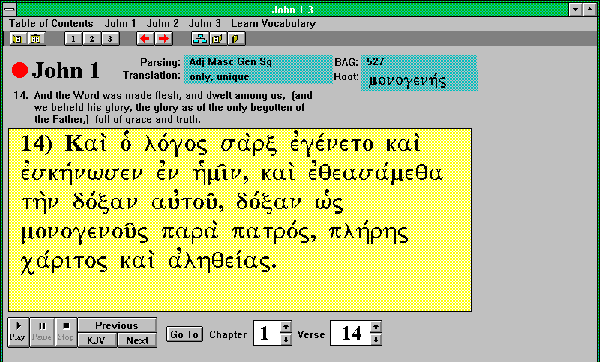 |
| Computers & Texts No.
13 | Table of Contents | December 1996 |
Michael Fraser
CTI
The learning of modern languages has been considerably assisted by the use of computer-based media. CD-ROMs proliferate which include audio and video, text, graphics, and interactive tests. Many applications also encourage the user to speak back to the computer by employing some form of voice recognition software. Multimedia CD-ROMs have also shifted away from the traditional text book approach of drill learning to integrating into the CD-ROM a flavour of the culture of the language. Of course, modern languages have much to draw upon, anything from television broadcasts, newspaper reports, through to interviews with the famous or the comfortingly ordinary. There is a sense in which the CD-ROM encapsulates the fact that it is teaching a living language rather than a text book language and that the best way to learn it is to emulate, as far as possible, the ways in which the user's first language was learnt‹by complete immersion. The development of multimedia applications for modern language learning is helped, of course, by the large available market (school, higher education, business, and tourist).
The learning of ancient languages, however, has a far smaller market. The learning of ancient Greek and Latin, for example, is effectively the learning of dead or static languages, taught for the purposes of reading rather than of speaking. Computer-assisted ancient language learning has a comparatively early history. Computers are patient and lend themselves to software which teaches facts by drills and memorization. The earlier packages were often textbooks on a disk and involved students completing paradigms by typing in the missing words, vocabulary tests, and the inclusion of texts and translations. Textbooks transferred to text-based software to teach the basics of a language for text translation.
The Greek and Hebrew Tutor CD-ROMs, recently published by Parsons Technology, claim, 'learn biblical Greek [or biblical Hebrew] through the interactive power of multimedia'. Are these equivalent to the multimedia CD-ROMs developed for modern language learning? Not exactly. The interface makes use of good design principles (large fonts and clickable buttons, navigation maps, and colour-coding) but the core lies firmly within the traditional drill and practice group of applications. In effect both the Greek and the Hebrew Tutors are textbooks on CD-ROM with the expected additional interactive tests and also a significant amount (though limited range) of audio.
Both CD-ROMs have very similar interfaces and the same author, Dr Ted Hildebrandt. Neither appear to be based on a single printed textbook (though references to Mounce, Basics of Biblical Greek appear frequently) but both are structured in the fashion of a printed book with chapters divided into Learn, Drill and Exercise sections. The Greek Tutor has a total of 28 chapters beginning with the Alphabet, Accents, Present Active Verbs, Second Declension Nouns, and ending with Mi Verbs, Numbers & Interrogatives, and Clause Types. The Hebrew Tutor, for its part, has 14 chapters beginning, as one would expect, with the Alphabet, Vowels and Nouns, and finishing with Imperatives, Infinitives and Participles. Each also has a Vocabulary Builder section and a fairly substantial biblical passage (from Ruth in the Hebrew and from John in the Greek). This is the basic table of contents and the final inclusion of an index of all chapters completes the textbook structure.
Taking a sample chapter will suffice to demonstrate the basic structure and elements of chapters on the CD-ROMs. Chapter three of the Hebrew Tutor teaches the Hebrew noun. The chapter opens with the Learn Menu the first topic of which is always the chapter's objectives, a description of what the student will be expected to know on completing the section. The topics range from learning Old Case Endings, Segholates and Geminates, to Plural Formation and Noun Formation. The menu also includes a vocabulary builder of high frequency nouns and a Scripture Memory Drill. Each topic is presented on a single screen with a central window the contents of which change according to the subtopic. The subtopics usually include a description of the subtopic and then examples of its usage. One quickly discovers that every Hebrew or Greek word in these Tutors is linked to a sound file which pronounces the word in question. British users will find it difficult to ignore the pronunciation of biblical Hebrew and Koine Greek with a distinctive North American accent. On occasions the audio pronunciation of a word is automatic and once one has learnt the pronunciation of the language then the voice can become a little irritating. For the most part the examples and some of the descriptions have been taken from printed textbooks, evidenced by the number of page references scattered throughout both CD-ROMs.
 |
Learning Hebrew Grammar with the Hebrew Tutor CD-ROM
Having completed the Learn menu one moves on to the Drill menu. For Hebrew nouns this includes drills on gender and number, pattern, plural formation and then Hebrew to English and English to Hebrew vocabulary drills. Each drill, in both the Hebrew and Greek Tutors, tends to be characterized by the presentation (and pronunciation) of a word, the meaning or correct form of which the student has to select from a multiple choice table. The student can also hear the pronunciation repeated, display the meaning, display the student's drill score, or move onto the next word. In the Noun Pattern drill the student is tested on a total of 68 words, a number only visible from the score button. Most of the drills in both Tutors are marked by expressions of success or failure, many of which are designed to appeal to the North American student ('swing and a miss), are rather over the top (being named a 'Hebrew wizard' for correctly identifying the word Ruth), or slightly bizarre ('Sorry, even Moses didn't get them all').
The final section of each chapter is the Exercise menu. The Exercises differ from the drills by requesting that the student build the correct word or form in Hebrew or Greek by selecting from a character map of consonants and vowels. The correct answer can be easily displayed and, as is the custom, each word can be pronounced when displayed. When the student is required to type in a phrase or a biblical verse then a 'major hint' is usually available.
Both CD-ROMs fulfil their purpose as electronic textbooks with basic means of interaction with the student. Neither are intended as standalone courses, both assuming that the student is participating in a traditional course centred around a printed textbook. For many who are able, or are required, to learn a language by this method the Tutors will provide a relatively inexpensive and slightly more effective means of doing so. However, by developing a textbook on CD-ROM the developers have missed out on the opportunity to evolve the teaching of ancient languages to something akin to the teaching of modern languages. There are now numerous resources available in digital form for teaching and researching Greek and Hebrew biblical studies. It would have been particularly attractive to move towards a greater integration of ancient language learning with the study of the texts for which the language provides a means to an end. The Greek Tutor could benefit from widening its scope from simply teaching Koine Greek to including, for example, a study of the Greek primary documents and the culture of the first century Graeco-Roman empire, so that the very reasons why students should be encouraged to know the language of the New Testament can be reinforced by almost seamless integration. Whilst the Hebrew Tutor acknowledges that the Hebrew of the Bible is little different to the Hebrew of modern Israel it makes no attempt to draw on examples which might be particularly suited to a multimedia application (excerpts from the rich musical heritage, the Jewish liturgy, modern Hebrew inscriptions, etc.). It seems less than adequate in a multimedia tutor of the Hebrew language, for example, to encourage students to sing the Hebrew alphabet to the tune of Yankee Doodle Dandy.
 |
Translating John 1 with the Greek Tutor CD-ROM
The Greek and Hebrew Tutors emphasise that there is no easy route to the learning of languages. For the most part the structure and vocabulary of the language has to be simply memorized. This is evident from the structure of the CD-ROM and it is reinforced by the inclusion of paper-based 'flash-cards' with each CD-ROM. The use of colour, clickable buttons, large fonts, and audio pronunciation might not make the learning of Greek or Hebrew any more enticing but this form of packaging could be suitable for revising one's knowledge of the languages when the only alternatives are paper-based textbooks and flashcards.
[Table of Contents] [Letter to the Editor]
Computers & Texts 13 (1996), 21. Not to be republished in any form
without the author's permission.
HTML Author: Michael
Fraser (mike.fraser@oucs.ox.ac.uk)
Document Created: 7 January 1997
Document
Modified:
The URL of this document is
http://info.ox.ac.uk/ctitext/publish/comtxt/ct13/fraser.html